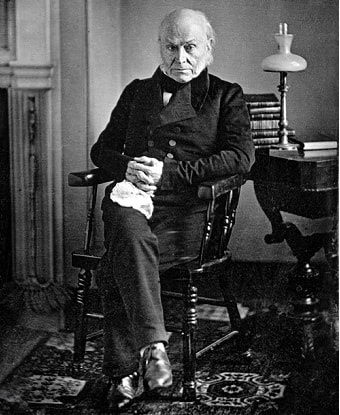Last updated: July 31, 2017
Person
John Quincy Adams and the Amistad Event

John Quincy Adams was seen as the perfect candidate to represent the Mende Africans before the Supreme Court. He had extensive experience within the government, had argued before the Supreme Court, negotiated international treaties, and abhorred slavery. The captives’ fate rested on his ability to successfully present their case to the Supreme Court.
Quincy Adams was born on July 11, 1767 in Braintree, Massachusetts to John and Abigail Adams. He graduated from Harvard University in 1787, and in 1790 was accepted into the Bar Association in Boston. He was appointed as the U.S. Minister to Holland by George Washington, and in 1797 became U.S. Minister to Prussia when his father was elected President.
After his father lost the 1800 election to Thomas Jefferson, Quincy Adams was elected to the Massachusetts Senate in 1802, and in 1803 he was elected to the U.S. Senate by the Massachusetts Legislature. When the war of 1812 began it was Adams who negotiated the Treaty of Ghent to end the war in 1814.
Adams served as Secretary of State under President James Monroe from 1817-1825. In this role he led discussions to resolve continued disputes with Great Britain and negotiated a more peaceful relationship. He arranged for the United States to purchase Florida from Spain, and was behind the Transcontinental Treaty, which established a border between US and Spanish land holdings.
In 1825 Adams became President. As President he advocated for a national university and naval academy system to help prepare future leaders; infrastructure improvements; and the survey of the United States’ lands, coasts, and resources. He lost re-election in 1829 and by 1830 had been elected to the U.S. House of Representatives where he fought to repeal the “gag rule,” which prohibited the discussion of slavery on the House floor.
In 1840 Lewis Tappan and Ellis Gray Loring of the Amistad Committee approached the 72-year old Adams to defend the Amistad captives. Initially hesitant, he eventually took the case believing it would be his last great service to the country. In February 1841 he argued the Mende were free men illegally captured and sold into slavery, and as such should be returned to Africa. After the Supreme Court ruled in favor of the captives Adams wrote his co-counsel, Roger Sherman Baldwin, saying, “The decision of the Supreme Court in the case of the Amistad has this moment been delivered by Judge Story. The captives are free...Yours in great haste and great joy.”
In November 1841 the Mende Africans gave Adams a bible as a token of thanks. An accompanying letter stated:
To The Honorable John Quincy Adams.
Most Respected Sir,
The Mendi People give you thanks for all your kindness to them. They will never forget your defence of their rights before the Great Court at Washington. They feel that they owe to you, in a large measure, their deliverance from the Spaniards, and from Slavery or Death. They will pray for you, Mr. Adams, as long as they live. May God bless and reward you!
We are about to go home to Africa. We go to Sierra Leone first, and there we reach Mendi very quick. Good missionary men will go with us. It has been a precious book to us in prison, and we love to read it now we are free. Mr. Adams, we want to make you a present of a beautiful Bible. Will you please accept it, and when you look at it or read it, remember your poor and grateful clients! We read in this holy book, “If it had not been the Lord who was on our side, when men rose up against us, then they had swallowed us up quick when their wrath was kindled against us….Blessed be the Lord, who hath not given us a prey to their teeth. Our soul is escaped as a bird out of the snare of the fowlers: the snare is broken, and we are escaped. Our help is in the name of the Lord, who made heaven and earth. Psalm CXXIV
For the Mendi People,
Cinque
Kinna
Kale
Boston, Nov. 6th. 1841
John Quincy Adams remained a vocal opponent to slavery until his death in 1848 when he suffered a stroke at the U.S. Capitol.
This is just one of many stories associated with the Amistad event. To learn more about others involved, please access the main People page of this itinerary.
Source:
“John Quincy Adams and the Amistad Event” pamphlet produced by Adams National Historical Park.
